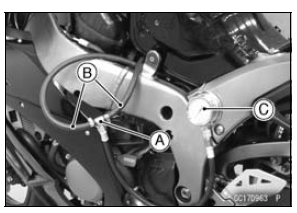

NOTE
Be sure the battery is fully charged.
Be sure to place a piece of cloth around the fuel outlet pipe of the fuel pump and the delivery pipe of the throttle body assy.
| WARNING Fuel is flammable and explosive under certain conditions and can cause severe burns. Be prepared for fuel spillage; any spilled fuel must be completely wiped up immediately. When the fuel hose is disconnected, fuel spills out from the hose and the pipe because of residual pressure. Cover the hose connection with a piece of clean cloth to prevent fuel spillage. |
Special Tools - Oil Pressure Gauge, 5 kgf/cm²: 57001-125
Fuel Pressure Gauge Adapter: 57001-1593
Fuel Hose: 57001-1607

| WARNING Fuel is extremely flammable and can be explosive under certain conditions resulting in serious injury or death. Do not try to start the engine with the fuel hoses disconnected. |
The fuel pump should operate for 3 seconds, and then should stop.
NOTE
After turning on the engine stop switch and ignition switch, inspect the fuel leakage from the connected portion of the special tools.
NOTICE
Do not drive the fuel pump 3 seconds or more without the fuel in the fuel tank. If the fuel pump is driven without the fuel, it may be damaged.
Fuel Pressure (with Engine Idling) Standard: 294 kPa (3.0 kgf/cm², 43 psi)
NOTE
The gauge needle will fluctuate. Read the pressure at the average of the maximum and minimum indications.
Turn the ignition switch to OFF.
Fuel Line Leakage (see Fuel Injector Fuel Line Inspection) Amount of Fuel Flow (see Fuel Flow Rate Inspection)
After above checks, measure the fuel pressure again.
Remove the fuel pressure gauge, hoses and adapter.
Install the removed parts (see appropriate chapters).
Start the engine and check for fuel leakage.
 Fuel Line
Fuel Line Fuel Flow Rate Inspection
Fuel Flow Rate InspectionRear Turn Signal Light Bulb Replacement
Remove the upper seat cover (see Seat Cover Removal
in the Frame chapter).
Disconnect the tail/brake light connector [A].
Turn the socket [A] counterclockwise and remove the
socket together with the bulb.
Push and turn the turn signal light bulb [A] counterclockwise
an ...
Exhaust Pipe Installation
Replace the exhaust pipe gaskets [A] and premuffler
chamber gasket [B] with new ones.
Install the premuffler chamber gasket to the premuffler
chamber [C] until it is bottomed so that the chamfer side
faces exhaust pipe [D].
Install the exhaust pipe clamp [E] as shown in the figure.
I ...
Special Tools
Bearing Puller:
57001-135
Head Pipe Outer Race Press Shaft:
57001-1075
Steering Stem Nut Wrench:
57001-1100
Bearing Driver Set:
57001-1129
Steering Stem Bearing Driver, 42.5:
57001-1344
Steering Stem Bearing Driver Adapter,
41.5:
57001-1345
Head Pipe Outer Race Driver, 55:
57001- ...